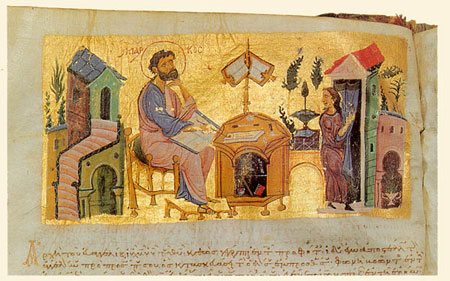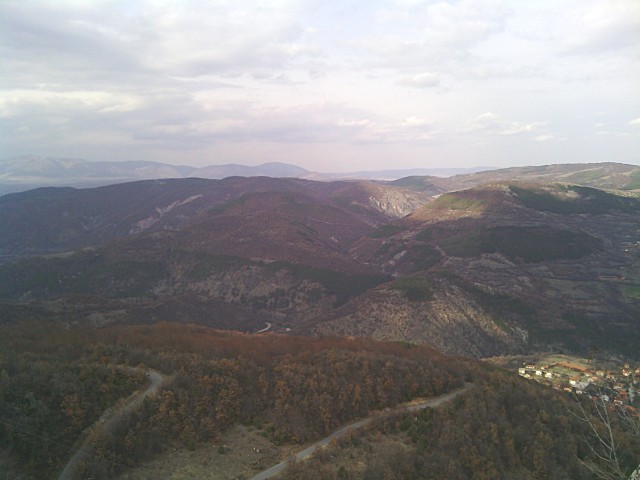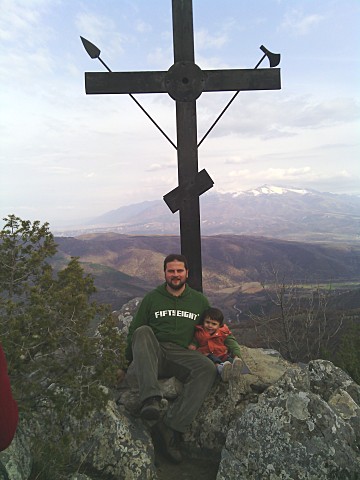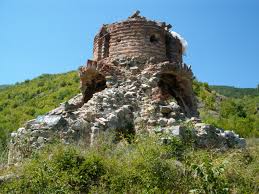![]()
Living of Saint Filothea of Tarnovo
The Venerable Filothea (Filotea) is born in the Byzantine city of Polivot in (Southern Thrace). She was a fruit of a continous prayers of her parents.
Received a good education for the time and reached adulthood, her parents give her for a bride (in arranged marriage against her will) which was a standard practice of its time.
Even merrying using her enormous wisdom she was able to persuade her husband to live vestal life (the marriage was not consumed).
In relatively short years her husband passed away. She has moved to a Insland nearby the close lake, built a small hermit cell hut and prayed and fasted incessantly living a a holy hermit life in solitude, night vigils, tears and repentance and stillness.
Because of her zealoutry God has given her the Grace of Miracle working prayers and the wisdom to teach. A well known spiritual persons, cleargyman, priests, deacons and people come to her to hear her graceful words and councils as well as to receive a healing through her holy prayers.
![]()
Cause of her absitence of food and sleep and praers all over the clock she lost body weight, forseeing her death she has presented herself to the Lord on 7th of December (the exact year of her death and the age are unknown, presumably she lived somewhere in the XII century). Her holy relics turned to be incorruptable (a sign for immerse holiness, among with wonder working healing miracles were considered some of the conditions for considering a deceased person a saint – for more on inccorruptability of saint relics check out my previous article here).
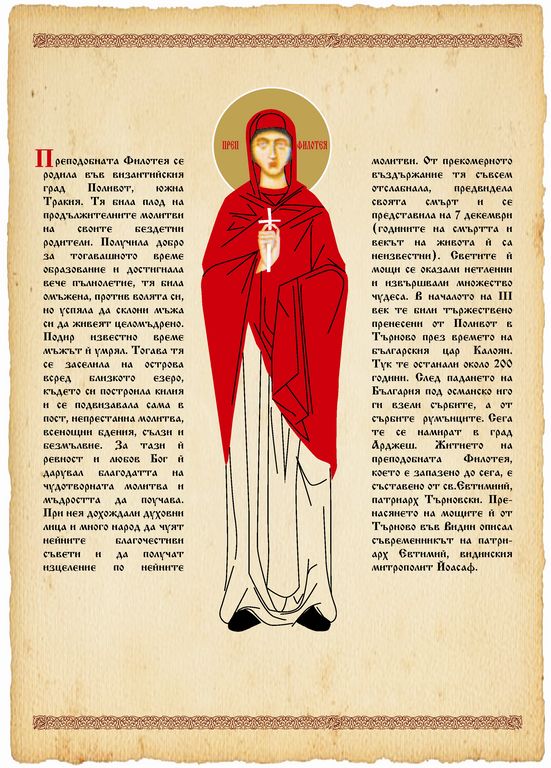
In the beginning of XIII century her holy relics were solemnly carried with honor from Polivot to the Capital of Second Bulgarian Empire Tarnovo by King Kaloyan. There her holy relics stayed by God's great providence for 200 years, being visited by the whole Christiandome for veneration.

After the fall of Bulgaria under the Ottoman yoke (year 1393). Probably to save the holy relics from destruction, they were taken to the far North Bulgarian borders in the Fortress of Bdin (today city of Vidin) and after staying for a while once the fortress was taken over by Mohameddans, taken a by the Serbs, and later Wallachs (todays Romanians) has taken the relics from Serbs, once the Serbian lands were invaded.
Currently her holy relics are present the old Wallachian Capital Curtea de Argeș (near river of Argeș).

Holy Relics of Saint Filothea, one of the most famous places for Christian veneration in Romania
(Saint Demetrius of Besarabia – another Bulgarian saint, Saint Filotea, and Saint Petka of Bulgaria are among the most venerated saints in Romania today)
The main source we have for the living of Saint Filothea (Filotheus) is written by Saint Patriarch Euthymius of Tarnovo Bulgaria (born circa 1325, died c.1402 / 1404). It is a very long document describing a lot of interesting details about Saint Filothea's healing miracles after she prayed with crying to the Lord even before she died. The miracle healings, chasing out of demons and restoration of eye sight and other glorious things continued even after she passed out to Christ to multitudes of people who prayed in front of her relics with faith.

Saint Patriarch Euthymiuus of Tarnovo, the main source author for today's Filoteas Living
During her life she spoke to the people coming to her a lot of his sacred methodical words.
She told them before her death:
"The time has come for me to leave here, so I thought it right to remind you of the traditions and decisions of the Orthodox faith by the Holy Apostles and the Divine Fathers. You know that the Orthodox faith is the head of our lives. In your efforts to give it to us pure and immaculate, the Holy Apostles suffered various kinds of death. , and to keep the church traditions unshakable, and not to waver here and there from different winds.
However, the Lord Jesus Christ shed His blood for her and did not allow his Church to be completely destroyed. But he gave her help, and fate led her to victory. I, the poor, have been brought up in piety since my childhood, and I received it from my parents as a precious treasure. Therefore, as a holy peak in the Church, I ask you not to forget the tradition of the Holy Prophets and Apostles, as the great apostle Paul wrote to Timothy: and others to learn! " (Tim. 2: 2)
![]()
You deserve to hold the true faith and not listen to pagan fables at all. They can rebuke us a thousand times, they can insult us a thousand times, but a lie will never defeat the truth, nor will malice prevail over wisdom. For, they reduced the name of the Deity in the creation, in men – oh wickedness! – in trees, in stones, cats, dogs, and are not ashamed to think that creation came into being by itself, and do not understand, the unthinking, in their evil wickedness and wisdom, that everything was brought from non-being into existence by one true God, Who created heaven and earth and everything visible and invisible. And the gods, who did not create the heavens and the earth, may perish! (Jeremiah 10:11). Let those who make them and who hope in them be like them! (Ps. 113:16; 134:18). Therefore the Gentiles were deceived, and their foolish hearts were darkened. Considering themselves to be wise, they proved foolish, and changed the glory of one God in the likeness of quadrupeds, reptiles, and birds (Rom. 1: 21-23). Let the wretched see where the celestial bodies and earthly beings in the air and water came from, and most of all where the even more primitive came from – heaven and earth, air and aquatic nature! Who mixed and divided them? What is their communication with each other – separation and consent? Who moves and leads them? How does one element, which is contrary in nature, run away with another harmlessly in the fullness of one world? How do they exist in agreement without consulting and talking? All this is the work of divine providence, and they left the Creator and honored and served creation instead of the Creator (Rom. 1:25) and wander in vain and rage against our pious faith and against pious Christians, to whom they impose ruthless torture and force them to renounce the sweet name of Christ.
You do not pay attention to their threats, even if they lead you to the torturous wheels, to the boiling cauldrons, to the sword or fire, do not be afraid of their horrors! (Isa. 8:12, 70s). Another life and another age that awaits us awaits us, where the prophets rejoice, the apostles rejoice together with the figures of the Venerable Lent, with the angels and archangels, with the martyrs and all the saints. Always think this, write this in your hearts! Take care of yourself and the whole flock, among which God has appointed you shepherds and teachers (Acts 20:28), in order to keep yourself and them pure and undefiled!
Everything in this world will be beautifully and habitually scattered like dust and forgotten, only virtue lasts forever and ever. Therefore, try to keep yourself clean and to lead the entrusted flock to lively pastures, so that the Lord of all, seeing this diligence of yours, may reward you with a reward worthy of your labors and make you worthy of His kingdom! "
![]()
Romanian Contemporary Icon of Saint Filothea
A high-ranking and famous man named Navkratius, from the city of Amoria, was appointed by the then king to be the governor of Greece. It happened to him to fight the godless Agarians (The Turks), and after the two sides fought, by the unknown destinies of God, his whole army was defeated: some were killed, and others were captured and taken to Sicily. Along with the others, a stratilat (army commanded) was captured, but his name was Artavan, from the town of Philomelia. Taken away by the ungodly, they were imprisoned in a gloomy dungeon and guarded with great care. Thus detained there, they were perplexed as to what to invent and what to do. And overwhelmed with grief, they called for the help of Almighty God and His loved ones.
Then Artavan remembered St. Philothea and began to tell them about her glorious miracles and that she had received the gift of healing various ailments and diseases. As he listened to Stratilat Navkratius, his heart burned and he began to call for her help. And because he was filled with divine desire and was inflamed with fervent faith, he could not wait to hide it for a long time, but he quickly got up and raised everyone to earnest prayer, shedding tears. And all of them unanimously rushed to earnest prayer and called for the help of the God-loving Philotheus, saying:
"Christ-related slave, undefiled bride, pure dove, abode of the Holy Spirit, if you look mercifully on us humble and desperate, and free us from this terrible dungeon, we will be trumpets of your countless miracles, with a loud voice we will we preach, and we will spend the rest of our lives chaste and pure. O Venerable Mother, do not despise us, for we are bitterly distressed in this terrible and miserable dungeon! "

With such prayers they spent the whole night, with hot tears and heartache. When they had finished this all-night vigil and finished their prayer, they lay down to rest and give a little sleepy consolation to the body. Everyone fell asleep in their place, the reverend appeared to them and rejoiced their hearts with words of consolation, saying:
"Your prayer has been heard and God has not despised your sighs. So go in peace and return to your homes, thanking God for your gratitude, who frees prisoners from bondage!" (Ps. 67: 7).
They awoke with joy, the iron chains lay fallen from them, the dungeon was wide open. They believed the vision to be true, and immediately left the open dungeon, the guard lying as if dead, and fleeing freely. But before they went home, they first went to the island to pay their respects to the reverend. After fulfilling this obligation, each of them returned home and told all the glorious miracles of the Venerable Philoteia.
After this spread everywhere, and managed to enter every ear, a leper, full of faith and fervent zeal, quickly came to the church of the Venerable Mother, called for mercy and with diligent requests and frequent bows, long sleepless nights, fasting and torture tormented himself and he relentlessly spent in her divine temple. The Blessed One, seeing his long diligence and his bodily leprosy, which had almost ended, immediately bowed to mercy, appeared in the dream of the church cleric and ordered him to anoint him with oil from the holy chandel of the Immaculate Conception all over his body. When he awoke, the cleric quickly obeyed the order. and not many days later he sent him safe to his home to glorify and thank God, as well as to His close friend.
A lot of time passed and many miracles happened. The Greek kingdom was exhausted and its scepter holders found themselves in difficult circumstances. Finding the right time, the Romans stormed the Greek state and inflicted unbearable misery.
At the same time, the Bulgarian kingdom became very strong and powerful, and it encompassed and conquered all the surrounding areas. At that time in Bulgaria the tsarist scepter was ruled well and even magnificently by the pious and glorious tsar Kaloyan (1197-1207). Seeing the Greek kingdom completely exhausted, he attacked it manfully, and many cities and villages were captured and ruined. And having gathered all the good, he brought it to his glorious city of Tarnovo – the whole nation with all the animals moved to their country. As he did all this, he heard the miracles of the Venerable Philotheus, and his heart was greatly inflamed. Because it is usually a matter of the souls of the pious to show zeal for virtue and to show zeal in every way.
After conquering the whole region and subduing it to his authority, he came to the place where the venerable body of the reverend lay, filled himself with unspeakable joy, praising God and diligently thanking Him. He fell before the reverend relics of the reverend, flooded them with his tears, and reverently kissed them. He then ordered an all-night vigil and gave many alms to the poor. In the morning a divine liturgy was celebrated, which was attended by the king in great joy and merriment with all his army. And he made the good decision to bring the reverend's body to his country.
Holy Venerable Mother Filothea pray the Lord to have mercy on every suffering and needy, poor, sick, weak and low and all the people who remember your holy memory and summon your prayers !
Amen !
Article Sources:
1. The Living of Saints by dr. Atanasii Bonchev and bishop Partenij
2. The Living of Saint Filothea written by Saint Patriarch Euthymius of Tarnovo

